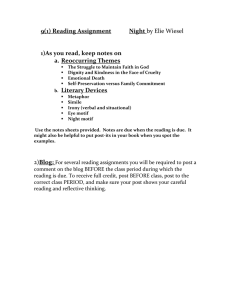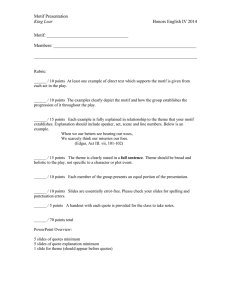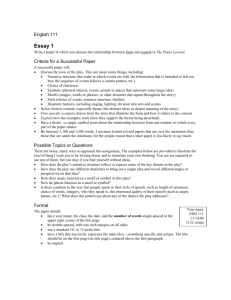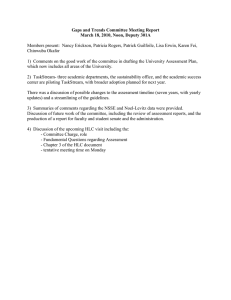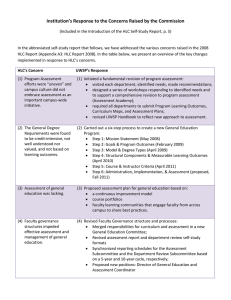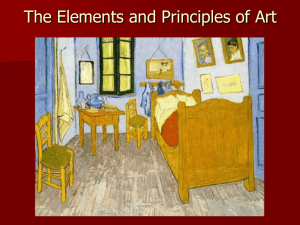Preliminary motifs for University Plan III
advertisement
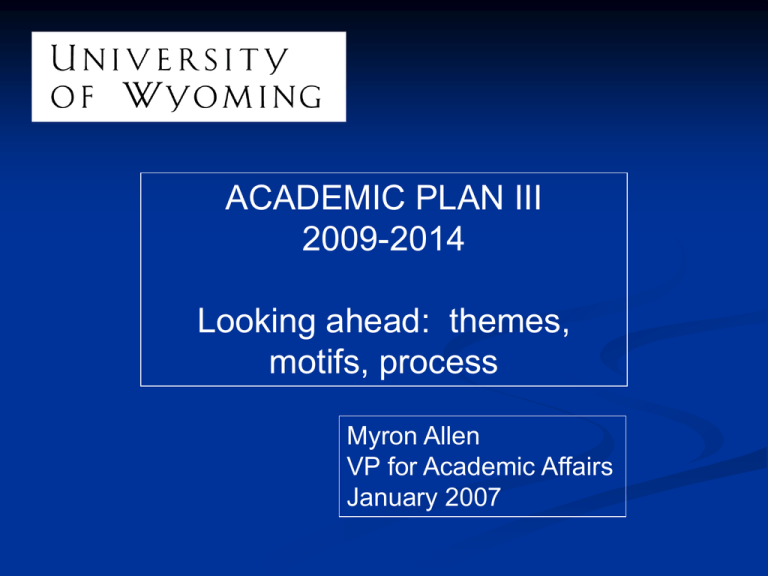
ACADEMIC PLAN III 2009-2014 Looking ahead: themes, motifs, process Myron Allen VP for Academic Affairs January 2007 Process: A template for communication Stage 1: Identifying the main issues and themes. Discussions, presentations, feedback Stage 2: Formulating specific ideas for discussion. Position papers, feedback, iteration Stage 3: Develop department- and college-level plans. Drafts, feedback, re-drafts Stage 4: Develop university-level plan. Draft, feedback, re-drafts Comments: UP3@uwyo.edu Motif 1: Building strength vs. adding breadth • UW has many strong programs. • Few of them have critical mass or bench depth. • A strong economy is an opportunity to build depth. • Adding new programs that have little existing foundation jeopardizes this opportunity. Interdisciplinarity is a pathway to depth: • by promoting shared interests among scholars, • by capitalizing on UW’s relatively small size, • by providing a richer learning environment. Motif 2: Reinforcing areas of distinction • Refine focus areas for building strength. • Provide opportunities for many departments — even small ones — to pursue excellence and depth. • Help attract the strongest new faculty members (scholarly communities = magnets). Areas of distinction in AP II: • Critical areas of science and technology • Cultural assets, arts, and humanities • Environment and natural resources • History and culture of the Rocky Mountain region • Life sciences • Professions critical to the state and region These aren’t written in stone, but it’s self-defeating to make sharp deviations from one 5-year plan to the next. A few specific issues related to areas of distinction • Science & Technology: • Flesh out Institute for Energy Research • Solidify computational science & links with NCAR • Focus UW’s materials science expertise • Cultural Assets • Strengthen fine arts infrastructure • Explore a humanities institute • Life Sciences • Continue defining life science focus areas • Link life sciences with other areas of science and ENR • Professions • Define the scope of clinical health science offerings • Use SER & NCAR as levers to bolster science education • Integrate UW’s contributions to business and rural community development (This is just a start.) Motif 3: Promoting access to higher education • The Hathaway scholarship program helps reduce financial barriers to baccalaureate education in Wyoming. • Other barriers remain: > Coordination of P-16 education statewide; > Preparation of students for college. • UW has additional responsibilities: > to extend opportunities to part-time students, lowincome students, place-bound students, students of color, nontraditional and first-generation students; > to formulate a sound, equitable tuition policy. Motif 4: Committing to excellence • Embed assessment of learning in UW’s academic culture. • Develop a strategic plan for enhancing masters’ and doctoral education. • Solidify UW’s culture in faculty hiring, reappointment, tenure, and promotion. • Develop strategies for recruiting top students. Motif 5: Providing leadership • Bolster UW’s role in the state’s public education system. • Build a strong, stable School of Energy Resources by: > cultivating contributions from many departments > enhancing communication with industry. • Translate expertise into public policy involvement. • Explore new possibilities for building Wyoming’s industrial research infrastructure and entrepreneurial. • Develop better mechanisms for cultivating leadership skills in early- and mid-career faculty members. • Enhance opportunities for students to build leadership. Process: tentative time line AY 2006-2007: Identify main issues Oct 2007: First position paper from Academic Affairs Mar 2008: Second position paper from Academic Affairs Aug 2008: Third position paper from Academic Affairs Sep 2008: Due date, first draft of department-level plans Oct 2008: Due date, first draft of college-level plans Jan 2009: First draft of university plan Mar 2009: Final drafts of all plans May 2009: Approval by Board of Trustees Each position paper and draft will allow time for feedback Strategic questions about the planning process 1. To what extent can UW unify its planning processes? • Academic plan (due 2009) • Support services plan • Capital facilities plan • Athletic plan 2. To what extent can we link the planning processes with the self-study required for HLC accreditation? • Self-study is due 2009. • HLC’s format is distinct from an academic plan. • HLC emphasizes themes important to our plans: Orientation to the future Focus on learning Connectedness (internally and externally) Distinctiveness. QUESTIONS? Spare slides follow Stakeholders Faculty & APs Students Staff members Academic administrators Other UW administrators Trustees External boards Public Prospective students Legislators Government agencies Potential donors
